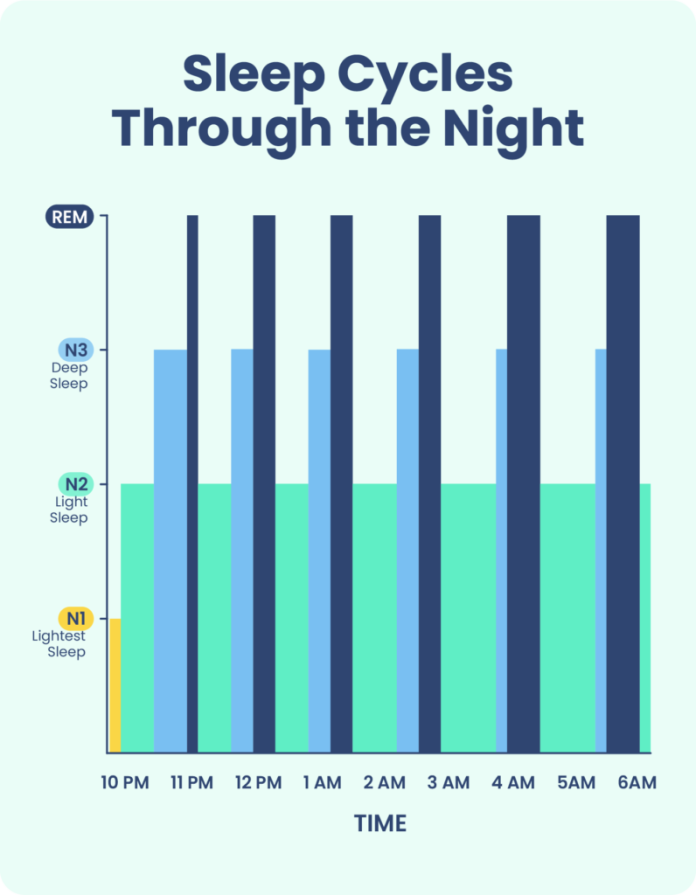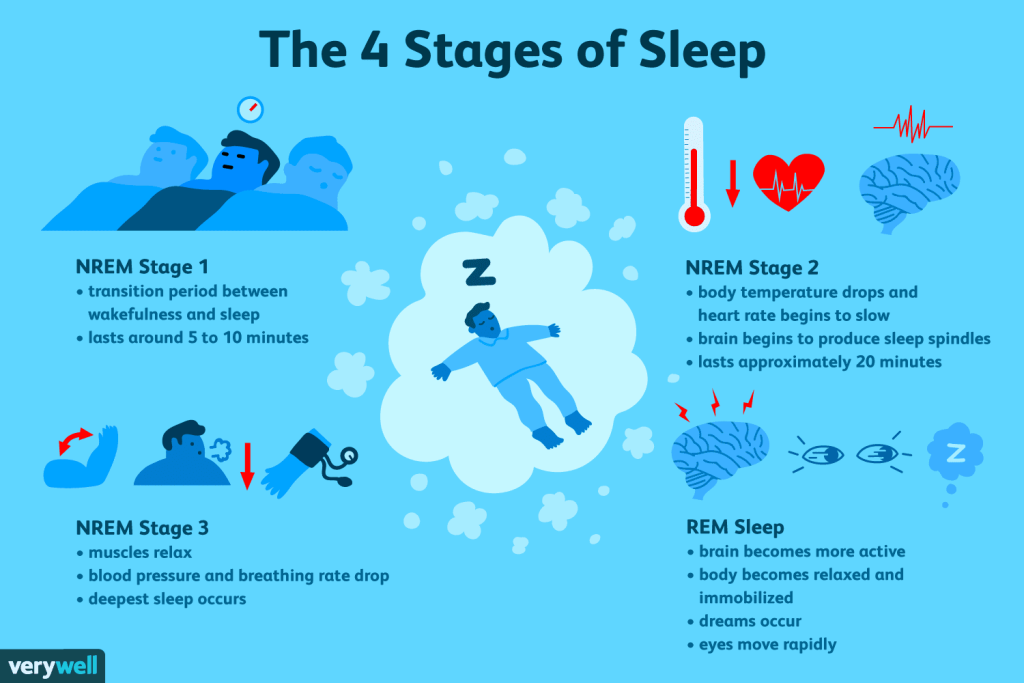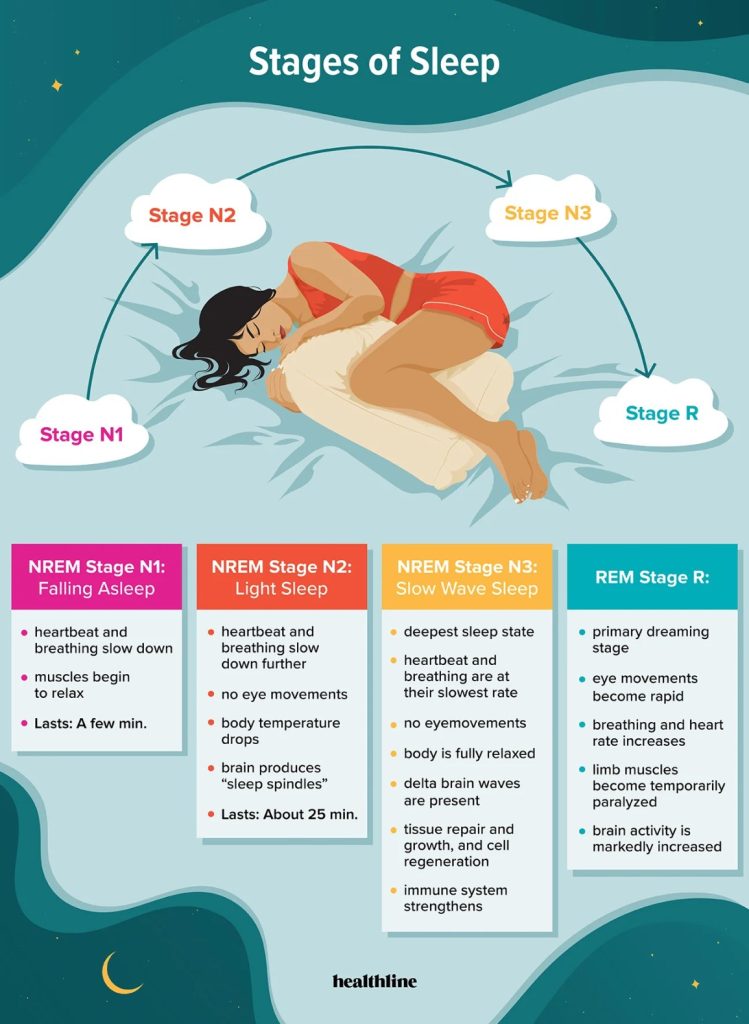Sleep is a fascinating and essential part of our daily lives. Have you ever wondered what happens to your body when you drift into dreamland?
In this article, you will explore the stages of sleep and gain a deeper understanding of what transpires in each phase.
From the moment you close your eyes to the time you wake up feeling refreshed, prepare to embark on a journey through the intricate stages of sleep.
So get comfortable, relax, and let’s uncover the mystery behind your slumber.
Review contents
Stage 1: NREM Sleep
Introduction to NREM Sleep
NREM sleep stands for non-rapid eye movement sleep, which consists of four stages.
This article will explore each stage in detail and discuss their characteristics, brain and body activity, duration, and significance in the sleep cycle.
Characteristics of Stage 1
Stage 1 of NREM sleep is the lightest and marks the transition from wakefulness to sleep. You are easily awakened during this stage, and your muscles are still active. Your eye movements may also be slow and rolling. It is common to experience sensations of falling or jerking as you drift off to sleep.
Brain and Body Activity in Stage 1
In stage 1, your brain activity starts to slow down, and you enter a relaxed state. Alpha and theta waves are prominent as you detach from your surroundings. These brain waves are slower in frequency and indicate a transition into a deeper sleep.
Duration of Stage 1 Sleep
Stage 1 of NREM sleep typically lasts for 5-10 minutes. It is a brief period that serves as a gateway to the deeper stages of sleep. As you progress through the sleep cycle, stage 1 becomes less prominent.
Significance of Stage 1 Sleep
Although stage 1 sleep is short, it is essential in preparing your body for deeper sleep stages. It allows you to disengage from wakefulness and enter a state of relaxation. Stage 1 serves as a transitional period before the onset of more restorative stages of sleep.
Stage 2: NREM Sleep
Introduction to Stage 2
Stage 2 is the second stage of NREM sleep and makes up a significant portion of your overall sleep time. It is characterized by distinct features that differentiate it from stage 1 and other sleep stages. Let’s delve into the details of stage 2 sleep.
Characteristics of Stage 2
During stage 2, your eye movements cease, and your body temperature decreases. Your brain waves become slower with occasional bursts of rapid activity known as sleep spindles. These sleep spindles are essential for memory consolidation and learning. Another characteristic of stage 2 sleep is the presence of K-complexes, which are large, slow waves that help protect the brain from potential environmental disturbances.
Sleep Spindles and K-Complexes
Sleep spindles, which are brief bursts of brainwave activity, enhance memory formation and learning. They are believed to play a role in transferring information from short-term to long-term memory. On the other hand, K-complexes are thought to be the brain’s response to external stimuli, such as noises, during sleep. They help keep you asleep and protect the continuity of your sleep.
Brain Activity in Stage 2
During stage 2 sleep, your brain activity further slows down compared to stage 1. Sleep spindles and K-complexes contribute to a stable, non-REM sleep state. The transition from stage 1 to stage 2 sleep marks the beginning of a deeper sleep cycle.
Duration of Stage 2 Sleep
Stage 2 sleep accounts for the most significant portion of your sleep cycle, typically lasting 45-60% of the total sleep time. This means you spend much of your night in this stage, highlighting its importance in sleep architecture.
Importance of Stage 2 Sleep
Stage 2 sleep is crucial for several functions. It promotes memory consolidation, enhances cognitive processes, and improves overall brain health. Stage 2 sleep is vital in restoring energy levels and improving immune function. Getting enough stage 2 sleep is essential for optimal physical and mental well-being.
Stage 3: NREM Sleep
Introduction to Stage 3
Stage 3, also known as slow-wave or deep sleep, is a critical sleep cycle phase. In this stage, your body undergoes significant physiological changes that promote physical restoration and rejuvenation. Let’s explore the characteristics and importance of stage 3 sleep.
Characteristics of Stage 3
Stage 3 is characterized by slow, high-amplitude brain waves called delta waves. These slow waves indicate a deep level of sleep and are associated with vital processes in the body. During this stage, your body repairs tissues, builds bone and muscle and strengthens the immune system.
Brain Waves in Stage 3
The prominent delta waves observed in stage 3 sleep distinguish it from the preceding stages. They are the slowest and largest brain waves, reflecting the deep sleep state. The synchronization of these waves across the brain is essential for the vital processes during this stage.
Duration of Stage 3 Sleep
The duration of stage 3 sleep varies throughout the night but tends to be longer during the first half of sleep.
In the early part of the night, you may spend up to 20-25% of your sleep time in stage 3. As the night progresses, stage 3 becomes shorter, and stages two and REM sleep become more prominent.
Vitality of Stage 3 Sleep for Physical Restoration
Stage 3 sleep plays a crucial role in physical restoration and recovery. During this stage, the body repairs and regenerates tissues promotes muscle growth, and releases growth hormones.
This deep sleep phase is essential for maintaining a healthy immune system, supporting organ function, and overall physical revitalization.
Association with Sleep Disorders
Disruptions in stage 3 sleep can lead to various sleep disorders.
Conditions such as sleep apnea and restless leg syndrome can interfere with stage 3 sleep, impairing the body’s ability to undergo necessary physiological repairs.
Identifying and treating these disorders is crucial for ensuring the therapeutic benefits of stage 3 sleep.
Stage 4: NREM Sleep
Introduction to Stage 4
Stage 4, called deep or delta sleep, is the final stage of NREM sleep.
The highest intensity of delta waves characterizes it and plays a pivotal role in physical recovery and restoration. Let’s delve into the characteristics and significance of stage 4 sleep.
Characteristics of Stage 4
During stage 4 sleep, the brain produces the highest amount of slow delta waves compared to any other sleep stage. These delta waves indicate a profound and vital sleep state. During this stage, your body experiences its most profound level of relaxation.
Delta Waves in Stage 4
Delta waves in stage 4 sleep are essential for promoting physical recovery. These slow, rhythmic waves synchronize across the brain, leading to profound relaxation and rejuvenation.
The generation of delta waves during stage 4 sleep supports the repair and growth of tissues, strengthens the immune system, and enhances overall physical well-being.
Deep Sleep and Physical Recovery
Stage 4 sleep is essential for physical restoration. During this stage, the body repairs and regenerates cells releases growth hormones, and strengthens the musculoskeletal system.
Deep sleep is vital for muscle recovery, wound healing, and optimal immune system functioning.
Relationship with Sleep Disorders
Disruptions in stage 4 sleep can be associated with sleep disorders such as sleepwalking and night terrors.
These parasomnias can interfere with the body’s ability to cycle through sleep stages properly, leading to fragmented and disrupted sleep. Identifying and addressing these sleep disorders is crucial for maintaining a healthy sleep architecture.
Transition to REM Sleep
Following stage 4 sleep, your sleep architecture transitions into a different sleep stage called rapid eye movement (REM) sleep. This transition from NREM sleep to REM sleep is a significant process in the sleep cycle.
Rapid Eye Movement (REM) Sleep
Introduction to REM Sleep
REM sleep is a distinct sleep cycle phase characterized by rapid eye movements and vivid dreaming. It is an active stage of sleep associated with various physiological and cognitive processes. Let’s explore the characteristics and importance of REM sleep.
Characteristics of REM Sleep
REM sleep is characterized by rapid eye movements, irregular heart rate, and increased brain activity resembling wakefulness.
Despite being deeply asleep, your brain is highly active during REM sleep, leading to intense dreaming. This stage is also known as paradoxical sleep due to the contrasting brain and body activity.
Brain Activity in REM Sleep
During REM sleep, your brain exhibits high-frequency and low-amplitude brain waves, similar to the wakeful state.
The regions responsible for learning, memory, and emotional processing become highly active during this stage. This increased brain activity is believed to be crucial in consolidating memories and processing emotions.
Eye Movements and Dreams
One of the distinctive features of REM sleep is the rapid movement of your eyes. These eye movements are closely associated with vivid dreaming.
During REM sleep, your brain is immersed in various dream scenarios, and your eyes follow the movements and events happening within the dream. This eye movement is a characteristic of the intense mental activity occurring during this stage.
Duration of REM Sleep
REM sleep occurs cyclically throughout the night, with each REM period becoming longer as the night progresses. On average, the first REM sleep episode lasts around 10 minutes, while the final episode lasts as long as an hour. REM sleep typically constitutes about 20-25% of your sleep time.
Significance of REM Sleep
REM sleep plays a vital role in cognitive function, emotional regulation, and memory consolidation.
It is essential for learning and problem-solving as it facilitates the organization and storage of newly acquired information. REM sleep is also linked to emotional processing and regulation, helping you maintain emotional well-being.
Sleep Cycle
Definition of Sleep Cycle
A sleep cycle refers to the progression of various sleep stages during a single sleep period. This repeating pattern is essential for maintaining a healthy sleep-wake cycle and ensuring optimal rest and restoration. Let’s examine the stages of sleep and their organization within a sleep cycle.
Stages of Sleep in a Sleep Cycle
A sleep cycle consists of four main stages: stage 1, stage 2, stage 3, and REM sleep. The cycle begins with stage 1, stage 2, stage 3, and finally enters REM sleep. The complete duration of a sleep cycle typically lasts for around 90-120 minutes.
Average Length of a Sleep Cycle
The average sleep cycle lasts approximately 90 minutes, but individual variations are common. Each sleep cycle consists of approximately 5-6 cycles throughout the night. REM sleep duration increases as the night progresses, while non-REM stages, such as stages 3 and 4, decrease.
Repetitive Nature of Sleep Cycles
Sleep cycles occur in a repetitive pattern throughout the night. After completing one cycle, your body returns to stage 1 sleep and proceeds through the different stages again.
This repetitive nature of sleep cycles ensures that your body experiences the benefits of each stage and allows for comprehensive restoration.
Importance of Regular Sleep Cycles
Maintaining regular sleep cycles is vital for overall sleep quality and well-being. Consistent sleep schedules help regulate circadian rhythms, enhance sleep efficiency, and improve the effectiveness of each sleep stage.
Establishing a regular sleep routine promotes better sleep habits and leads to more restorative sleep.
Non-Rapid Eye Movement (NREM) Sleep vs. REM Sleep
Understanding NREM Sleep
NREM sleep consists of stages 1, 2, 3, and 4, characterized by slow brain waves and limited muscle activity. NREM sleep is crucial for physical restoration, memory consolidation, and learning. It primarily focuses on repairing the body and preparing for REM sleep.
Understanding REM Sleep
REM sleep is a unique stage characterized by rapid eye movements, intense brain activity, and vivid dreaming. It is associated with cognitive processes, emotional regulation, and memory consolidation. REM sleep focuses on mental restoration and may have a role in creative thinking.
Differences in Brain Activity
The brain activity during NREM and REM sleep differs significantly. NREM sleep is characterized by slow wave activity, with brain waves becoming progressively slower and more significant in amplitude throughout the stages. In contrast, during REM sleep, brain activity resembles wakefulness with high-frequency, low-amplitude waves.
Dreaming in NREM Sleep vs. REM Sleep
Vivid dreaming primarily occurs during REM sleep, where dreams are often emotional, complex, and immersive. NREM sleep also involves dreaming, but the dreams tend to be less intense and more fragmented. Dreaming in NREM sleep is less visually vivid, with fewer narrative elements than in REM sleep.
Sleep Disorders and NREM-REM Imbalance
Sleep disorders such as insomnia, sleep apnea, and narcolepsy can disrupt the balance between NREM and REM sleep stages. These imbalances can lead to fragmented sleep, excessive daytime sleepiness, and impaired cognitive function. Addressing these sleep disorders is essential for achieving a healthy balance between NREM and REM sleep.
Sleep Architecture
Definition of Sleep Architecture
Sleep architecture refers to the structure and organization of sleep stages throughout the night. It encompasses the distribution, duration, and progression of different sleep stages within a sleep cycle. Understanding sleep architecture is crucial for assessing sleep quality and diagnosing sleep disorders.
Components of Sleep Architecture
Sleep architecture comprises four main components: stages 1, 2, 3, and REM sleep. These stages occur in a cyclical pattern, each serving specific functions. The organization and proportion of these stages vary throughout the night, reflecting the body’s need for restoration and recovery.
Cyclic Nature of Sleep Architecture
Sleep architecture follows a cyclical pattern, with each sleep stage recurring sequentially. The cycle begins with stage 1 sleep and progresses through the subsequent stages, culminating in REM sleep. This repetition of sleep stages ensures comprehensive restoration and optimal functioning of various physiological processes.
Sleep Stages and Sleep Architecture
The arrangement and proportion of sleep stages within sleep architecture vary between individuals and depend on various factors, including age, sleep disorders, and personal characteristics. Some individuals may experience more deep sleep (stages 3 and 4), while others may have extended REM sleep periods.
Sleep Disorders and Sleep Architecture
Sleep disorders can significantly disrupt the natural sleep architecture. Conditions like sleep apnea, insomnia, and restless leg syndrome can lead to fragmented sleep, prolonged awakenings, and imbalances in sleep stages. Monitoring and addressing these sleep disorders are essential for restoring a healthy sleep architecture.
Monitoring Sleep Stages
Polysomnography
Polysomnography is a comprehensive sleep study that monitors various physiological parameters during sleep. It involves the simultaneous recording of brain activity (EEG), eye movements (EOG), muscle activity (EMG), and other physiological signals to assess sleep stages accurately. Polysomnography provides valuable insights into sleep architecture and is used in diagnosing sleep disorders.
Electroencephalography (EEG)
Electroencephalography (EEG) is a technique used to measure and record the electrical activity of the brain.
It plays a crucial role in monitoring sleep stages by detecting different brain wave patterns associated with wakefulness, NREM sleep, and REM sleep. EEG provides valuable information about the quality and duration of each sleep stage.
Electrooculography (EOG)
Electrooculography (EOG) measures the movement of the eyes by recording the electrical signals generated by eye muscles. EOG is particularly useful for detecting rapid eye movements during REM sleep. By monitoring eye movements, sleep specialists can accurately identify the onset and duration of REM sleep stages.
Electromyography (EMG)
Electromyography (EMG) measures the electrical activity of muscles. During sleep, EMG helps assess changes in muscle tone and activity.
Increased muscle tone can indicate sleep apnea or periodic limb movement disorder. Monitoring muscle activity through EMG provides valuable insights into sleep disorders and muscle-related sleep disturbances.
Advancements in Sleep Stage Monitoring
Advancements in technology have led to the development of wearable devices and smartphone applications that can monitor sleep stages.
These devices use a combination of accelerometers and heart rate sensors to estimate sleep stages based on movement patterns and heart rate variability. While not as comprehensive as polysomnography, these technologies provide valuable insights into sleep patterns and trends.
Impact of Sleep Deprivation
Effects of Sleep Deprivation on Sleep Stages
Sleep deprivation can profoundly affect the different sleep stages. Studies have shown that sleep deprivation decreases slow-wave sleep (stages 3 and 4), while REM sleep rebounds during recovery sleep. This disruption in sleep stages can impair cognitive function, mood, and overall well-being.
Cognitive Impairment Due to Sleep Deprivation
Sleep deprivation negatively impacts cognitive function. It impairs attention, concentration, memory, and problem-solving abilities. Sleep deprivation can lead to cognitive decline, decreased productivity, and an increased risk of accidents or errors.
Mood and Emotional Consequences
Lack of sleep can significantly impact your mood and emotional well-being. Sleep deprivation often leads to irritability, mood swings, increased stress levels, and a greater vulnerability to negative emotions.
Chronic sleep deprivation is also associated with an increased risk of developing mental health disorders such as depression and anxiety.
Physical Consequences of Sleep Deprivation
Sleep deprivation can have various physical consequences. It weakens the immune system, making you more susceptible to illnesses and infections.
Chronic sleep deprivation has been linked to an increased risk of cardiovascular diseases, obesity, diabetes, and chronic pain conditions. It can also affect hormone regulation and increase the likelihood of weight gain.
Strategies for Quality Sleep and Avoiding Deprivation
To ensure quality sleep and avoid sleep deprivation, it is essential to establish a consistent sleep schedule, create a conducive sleep environment, and practice healthy sleep habits.
These habits include limiting exposure to electronic devices before bedtime, avoiding stimulants like caffeine, and incorporating relaxation techniques into your bedtime routine.
Prioritizing sleep as an essential part of overall well-being is critical to maintaining healthy sleep patterns.
































